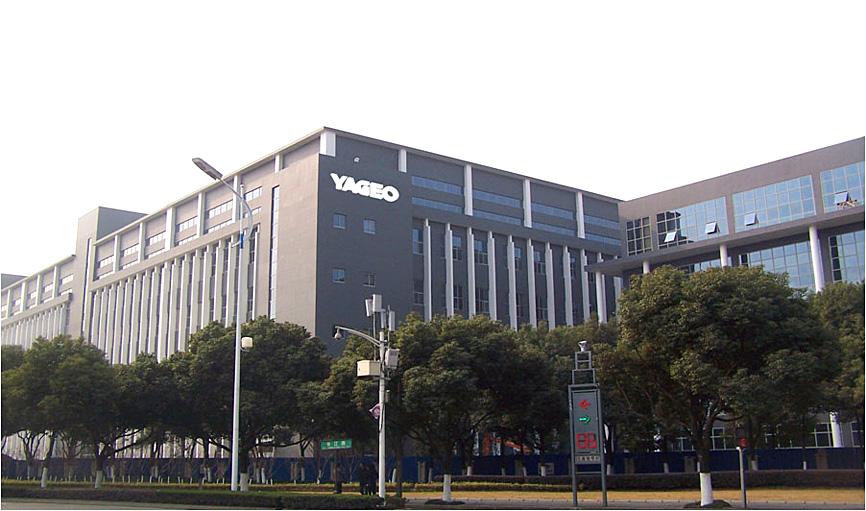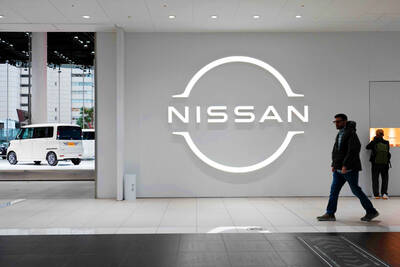Yageo Corp (國巨) yesterday said that its revenue would drop by a low single-digit percentage this quarter from a historical high last quarter, as customers and distributors are holding back demand to concentrate on inventory digestion due to flagging smartphone and notebook computer demand.
The world’s biggest supplier of passive components expects to take three to six months to reduce its inventory of commoditized passive components to a normal level of 100 to 110 days, from 130 days currently.
Yageo would reduce its factory utilization rate for standard passive components to about 60 percent this quarter, from about 70 percent last quarter, to reach its inventory goal by the end of this year or in the first quarter of next year, it said.

Photo: Chang Hui-wen, Taipei Times
Passive components such as resistors, capacitors and inductors are integral parts of a motherboard.
“The second half of the year should continue to be challenging. The inventory situation has not really improved. The standard segment continues to weigh on operations,” Yageo chief financial officer Eddie Chen (陳彥松) told investors. “The book-to-bill ratio for premium products stands at about one, but below one for standard products”
On the bright side, Yageo still sees solid demand for premium passive components used in automotive, industrial and networking devices, leading to high utilization of those product lines at 90 to 100 percent, Chen said.
Those premium passive components accounted for 75 percent of Yageo’s revenue last quarter.
Gross margin would this quarter slide to a level similar to the first quarter at 38.1 percent, compared with 38.8 percent in the April-to-June period, Chen said.
Operating profit margin would also be similar to the first quarter at 24.8 percent, a slight decline from 25.2 percent last quarter, he said.
Yageo attributed the stable margins to its persistent efforts to broaden its product portfolio over the past few quarters.
Thanks to its diverse offering, Yageo should be able to “resist” the pricing pressure in the second half of this year when the market is expected to slow, Chen said.
The company said it would keep its capital expenditure budget for this year unchanged at NT$10 billion to NT$11 billion (US$334 billion to US$367.4 billion), as it believes the industry is still on track to grow in the long term.
Yageo reported NT$5.93 billion in net profit for the quarter ending June 30, surpassing its share capital of NT$5.44 billion. That represented an annual decline of 6.4 percent from NT$6.33 billion and a quarterly drop of 5.1 percent from NT$5.24 billion.
Earnings per share fell to NT$11.05 last quarter from NT$12.82 percent in the second quarter of last year and down from NT$11.59 in the first quarter of this year.
The company had to pay a higher income tax bill due to undistributed earnings of about NT$600 million last year, which led to a NT$1 drop in earnings per share last quarter, it said.
Gross margin and operating profit margin improved on a quarterly basis, thanks to a better product mix and greater revenue scale, it said.
Revenue expanded 13 percent year-on-year and 3.9 percent quarter-on-quarter to NT$31.32 billion last quarter, a new record.

Nissan Motor Co has agreed to sell its global headquarters in Yokohama for ¥97 billion (US$630 million) to a group sponsored by Taiwanese autoparts maker Minth Group (敏實集團), as the struggling automaker seeks to shore up its financial position. The acquisition is led by a special purchase company managed by KJR Management Ltd, a Japanese real-estate unit of private equity giant KKR & Co, people familiar with the matter said. KJR said it would act as asset manager together with Mizuho Real Estate Management Co. Nissan is undergoing a broad cost-cutting campaign by eliminating jobs and shuttering plants as it grapples

TEMPORARY TRUCE: China has made concessions to ease rare earth trade controls, among others, while Washington holds fire on a 100% tariff on all Chinese goods China is effectively suspending implementation of additional export controls on rare earth metals and terminating investigations targeting US companies in the semiconductor supply chain, the White House announced. The White House on Saturday issued a fact sheet outlining some details of the trade pact agreed to earlier in the week by US President Donald Trump and Chinese President Xi Jinping (習近平) that aimed to ease tensions between the world’s two largest economies. Under the deal, China is to issue general licenses valid for exports of rare earths, gallium, germanium, antimony and graphite “for the benefit of US end users and their suppliers

Dutch chipmaker Nexperia BV’s China unit yesterday said that it had established sufficient inventories of finished goods and works-in-progress, and that its supply chain remained secure and stable after its parent halted wafer supplies. The Dutch company suspended supplies of wafers to its Chinese assembly plant a week ago, calling it “a direct consequence of the local management’s recent failure to comply with the agreed contractual payment terms,” Reuters reported on Friday last week. Its China unit called Nexperia’s suspension “unilateral” and “extremely irresponsible,” adding that the Dutch parent’s claim about contractual payment was “misleading and highly deceptive,” according to a statement

The Chinese government has issued guidance requiring new data center projects that have received any state funds to only use domestically made artificial intelligence (AI) chips, two sources familiar with the matter told Reuters. In recent weeks, Chinese regulatory authorities have ordered such data centers that are less than 30 percent complete to remove all installed foreign chips, or cancel plans to purchase them, while projects in a more advanced stage would be decided on a case-by-case basis, the sources said. The move could represent one of China’s most aggressive steps yet to eliminate foreign technology from its critical infrastructure amid a